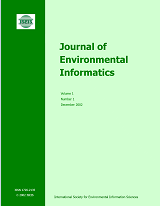© Thomson Reuters Journal Citation Report 2021.
Vol 44, Issue 1 (September 2024)
| Decentralized Algae Removal Technologies for Lake Diefenbaker Irrigation Canals: A Review |
PDF
|
| S. H. Safaei, S. Young | 1-16 |
| Real-Time LNG Buses Emissions Prediction Based on a Temporal Fusion Trans-Formers Model |
PDF
|
| Q. C. Liu, F. X. Gao, J. Y. Zhao, Y. F. Cai, L. Chen, C. Lv | 17-33 |
| Reducing Carbon Emission, Groundwater Over-Exploitation and Energy Consumption on Agricultural Lands by Off-Farm Water Management Practices: Modernization of Surface Water Distribution Systems |
PDF
|
| P. Noorbeh, R. Stepanian, M. Noorbeh, M. Movahedinia, S. M. Hashemy Shahdany | 34-47 |
| Modelling Soil δ13C across the Tibetan Plateau Using Deep-Learning |
PDF
SI
|
| T. Zhou, Y. S. Lai, Z. H. Yang, Y. H. Shi, X. R. Luo, L. Liu, P. Yu, G. Chen, L. X. Cao, S. H. Fan, C. J. Cai, J. Sun, S. H. Chen, H. Y. Lu, X. L. Ma, S. D. Li, X. L. Tang | 48-60 |
| Impact of Carbon Emissions and Advance Payment on Optimal Decisions for Perishable Products via Parametric Approach of Interval |
PDF
|
| H. Ali, M. A. Khan, A. A. Shaikh, A. F. Alrasheedi | 61-72 |
| Prediction of the Breeding and Wintering Ranges of Pomacea canaliculata in China Using Ensemble Models |
PDF
SI
|
| Z. Qin, J. H. Yang, T. Gan, J. E. Zhang, Y. M. Liu, F. C. Yao, B. L. Zhao | 73-86 |
Aims and Scope
Journal of Environmental Informatics (JEI) is an international, peer-reviewed, and interdisciplinary publication designed to foster research innovation and discovery on basic science and information technology for addressing various environmental problems. The journal aims to motivate and enhance the integration of science and technology to help develop sustainable solutions that are consensus-oriented, risk-informed, scientifically-based and cost-effective. JEI serves researchers, educators and practitioners who are interested in theoretical and/or applied aspects of environmental science, regardless of disciplinary boundaries. The topics addressed by the journal include:
- Planning of energy, environmental and ecological management systems
- Simulation, optimization and Environmental decision support
- Environmental geomatics - GIS, RS and other spatial information technologies
- Informatics for environmental chemistry and biochemistry
- Environmental applications of functional materials
- Environmental phenomena at atomic, molecular and macromolecular scales
- Modeling of chemical, biological and environmental processes
- Modeling of biotechnological systems for enhanced pollution mitigation
- Computer graphics and visualization for environmental decision support
- Artificial intelligence and expert systems for environmental applications
- Environmental statistics and risk analysis
- Climate modeling, downscaling, impact assessment, and adaptation planning
- Other areas of environmental systems science and information technology
© 2024 ISEIS - International Society for Environmental Information Sciences
